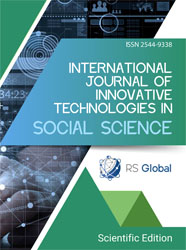TOTALITARIAN STATE AND TWO DECADES OF GEORGIAN CINEMATOGRAPHY
Abstract
The research discusses how the totalitarian state was being formed during two decades, on the example of Georgian cinema of 1920s and 1930s; the trends of the “new human” and those seen in change from avant-garde film process to socialist realism, created by totalitarian cinema. Propaganda cinema significantly empowered the ideological basis of totalitarianism.
Based on the study of important archival materials and films (My grandmother, Jim Shuante, etc.), the methods of shooting and editing, angles and long panoramas, light and shadow, everything that characterized the innovators, are revealed.
In the 1930s, the Soviet Government needed cinema more than ever. The form of development of cinematography in the Soviet Union during the 20s, did not satisfy the authorities in any way.
The main theoretical-ideological basis of the "Cinema-Stalinism" (Kinostalinism) system revealed that Stalinist totalitarianism operated by considering the psychology of the masses. Therefore, the "people's" films created in the 1930s are not only part of the mass culture formed during that period, but also part of Stalin's state policy in creating the "new human".
In the 1930s, the Bolshevik State managed to establish total control over cinematography. The idea of cinema was "simplified" and the era of search for novelties was lost. The declared primitive cinematography, which only had a utilitarian, propaganda function, existed for quite a long time, almost until the 60s of the 20th century; and for a long time preserved in a part of viewers the myth of the main function of cinema - the "happy" world.
References
(1932). For Proletatian Art, pp. 1-2.
Berdyayev, N. (1960). The Origin of Rassian Communism. Michigan.
Beskin, O. (1928). Some features from the life of Sovkino. Soviet Cinema #1, 3.
Documentation. (2005). Kremlin Cinema 1928-1953. Moscow: ROSSPEN.
Documentation. (2005). Kremlin cinema. 1928-1953. Moscow: Publishing house ROSSPEN.
Documentation. (2005). Kremlin Cinema. Conversation 1934 Octomber 7. Moscow: Rosspen.
Dumbadze, S., & Dzanzava, N. (2017). Kote Mikaberidze. Tbilisi: Public Publishing House.
Eisenstein, S. (1964). Selected worksin 6 volumes. Moscow: Iskusstvo.
Fomin, V. (2019). Cinema and Power . House Materik.
Kalandarishvili, L. (2014). Spiritual Values - Eternity and Relativism. Tbilisi: Shota Rustaveli Theatre and Film Georgia State University.
Khatiashvili, T. (2022). Soviet Fairy Tale About Good and Evel. Tbilisi: National Centre of Georgia.
Kontridze, E. (2022). Sakhkinmetsv - Exemplary Punishment. Tbilisi: Natioanl Center of Georgia.
Kravchenko, A. (2018, 10). Arzamas. Retrieved from Creation of a new man: https://arzamas.academy/materials/1499
Ochiauri, L. (2022). In Time And Against Time. Tbilisi: National Center of Cinematography of Georgia.
Our Cinema. (1931, December 14). Pravda, p. 2.
Party congress on sinema. (1928). Soviet Cinema #1, 28.
Personal File, Fund-1, Folder-1783, manuscrip-168 (Art Palace).
Personal files, Art Palace (Fund-1, Folder-1783, manuscript-182).
Tikanadze, R. (1978). Georgian Cinema of the Problem of Searching. Tbilisi.
war, B. r. (n.d.). https://arzamas.academy/materials.
Yampolsky, M. (1982). Cinema "Total" and "Montage". Art of Cinema #7.
Zhelev, Z. (1995). Fascism. Moscow.
Views:
113
Downloads:
115
Copyright (c) 2025 Rusudan Kvaratskhelia

This work is licensed under a Creative Commons Attribution 4.0 International License.
All articles are published in open-access and licensed under a Creative Commons Attribution 4.0 International License (CC BY 4.0). Hence, authors retain copyright to the content of the articles.
CC BY 4.0 License allows content to be copied, adapted, displayed, distributed, re-published or otherwise re-used for any purpose including for adaptation and commercial use provided the content is attributed.











